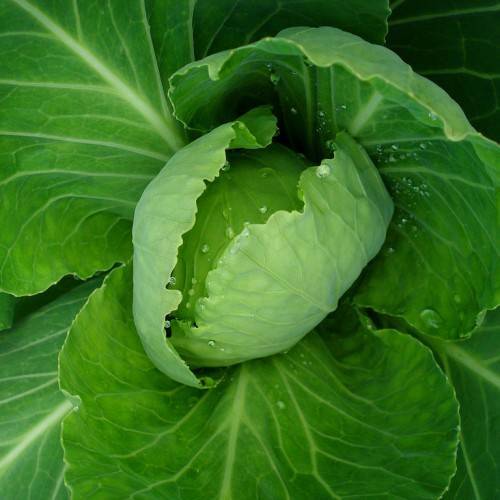
cabbage
Brassica oleracea (Capitata Group)
Cycle:
Annual
Watering:
Average
Hardiness Zone:
2 - 11
Flowers:
Flowers
Sun:
full sun
Fruits:
Fruits Ready In
Leaf:
Yes
Growth Rate:
Low
Maintenance:
Low
Care Level:
Medium
watering
Cabbage should be watered every 5-7 days, depending on weather conditions. The soil should be kept moist but not wet, so water lightly and avoid saturating the soil. During dry conditions, water more frequently and water until the water runs out of the bottom of the pot. Try to water in the morning or early evening. Avoid letting the leaves get wet in order to prevent diseases such as powdery mildew or black rot.
sunlight
Cabbage (Brassica oleracea (Capitata Group)) prefers to grow in full sunlight. An ideal location for growing cabbage would receive at least 6 to 8 hours of direct sunlight each day during the growing season. If possible, the cabbage should receive more than 8 hours of direct sunlight, albeit in filtered or dappled sunlight during the hottest part of the day. During the early stages of growth, the plants should receive cooler temperatures in the morning and evening and receive the full amount of sunlight during the daytime hours. In hot areas, some shading during the heat of the day might be needed. If your cabbage does not receive enough sunlight, the heads may fail to form properly, or be small and lacking in flavor.
pruning
Cabbage should be pruned when it is young and when there are 6 to 8 leaves to ensure proper growth and development. In general, pruning should be done when the plant is about 4 to 5 inches tall, as individual branches can be easily identified. Pruning should be done by removing old and diseased outer leaves, as well as stems that are growing too close to the center of the plant. This will encourage outward growth and ensure that the remaining leaves develop properly. Prune off the top 1/3 of the main stem, and then pinch off any additional adjacent stems that are competing and growing too close together. Prune off any flower buds as soon as they appear so that the plant focuses its energy on leaf development. Enjoy your healthy and productive cabbage plant!
Season
Hardiness Map
FAQ
Are Brussels sprouts a type of cabbage?
Yes, Brussels sprouts are a type of cabbage. They are thought to have originated in the area around Brussels, Belgium, which is how they got their name. They are a small, cabbage-like vegetable, usually about the size of a quarter, and have an outer layer that ranges in color from green to reddish-purple. They are nutritionally packed, containing a variety of vitamins, minerals, and antioxidants.
Are Brussels sprouts grown above the ground?
Yes, Brussels sprouts are grown above the ground. The vegetable is actually a member of the cabbage family and is a small, round vegetable that looks similar to a miniature head of cabbage. Brussels sprouts are typically grown in much the same way that other head crops like cabbage or broccoli are grown with the plants maturing into a stalk with the small sprouts forming all around the stalk from the bottom up. The sprouts can then be harvested with the stalk.
Do Brussels sprouts contain vitamin C?
Yes, Brussels sprouts do contain vitamin C. In fact, they are a good source of this essential nutrient. One cup of cooked Brussels sprouts contains about 48 mg of vitamin C, which contributes to 55% of your daily value. Vitamin C is a powerful antioxidant and is important for the growth and repair of tissues in the body, as well as for wound healing.
Is it safe to eat Brussels sprouts raw?
While eating Brussels sprouts raw is considered to be safe, it is generally not recommended. Raw Brussels sprouts can be tough and difficult to digest, and may be bitter in flavor. If you choose to eat them raw, make sure they’re fresh and thoroughly washed to avoid the risk of foodborne illness. For a healthier and tastier option, try lightly steaming or roasting your raw Brussels sprouts. This will help to reduce any bitterness while helping to make them more digestible.
Is Brussels sprouts low in calorie vegetable?
Yes, Brussels sprouts are a very low in calorie vegetable. One cup of cooked Brussels sprouts only contains 56 calories. They are also very low in fat and cholesterol, making them a healthy part of any meal. In addition to their low calorie content, Brussels sprouts contain important nutrients like vitamins A, C, K, B vitamins, minerals, fiber, and antioxidants. They can be eaten raw, cooked, or roasted, so you can find a way to make them a delicious part of any meal.
Do Brussels sprouts have different varieties?
Yes, Brussels sprouts do have different varieties. Common varieties of Brussels sprouts include long island, jade cross, and conehead. Long island sprouts have large, yellow-tinged leaves and a nearly uniform, globe shape. Jade cross is a newer variety which produces vigorous plants with large, dark green sprouts. Conehead is another popular variety as it tends to produce sprouts with a tip that tapers into a cone rather than a tight ball. All varieties of Brussels sprouts are known for their nutty flavor and crisp texture.
